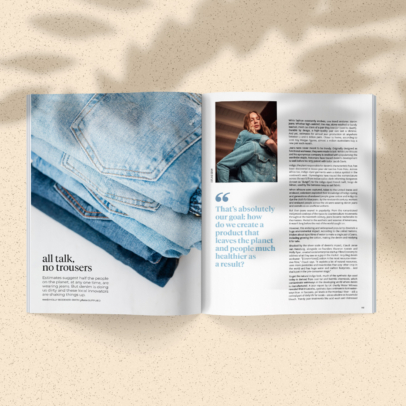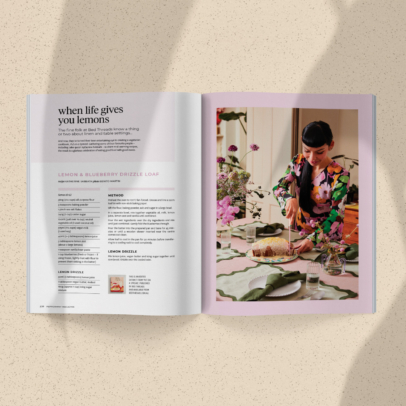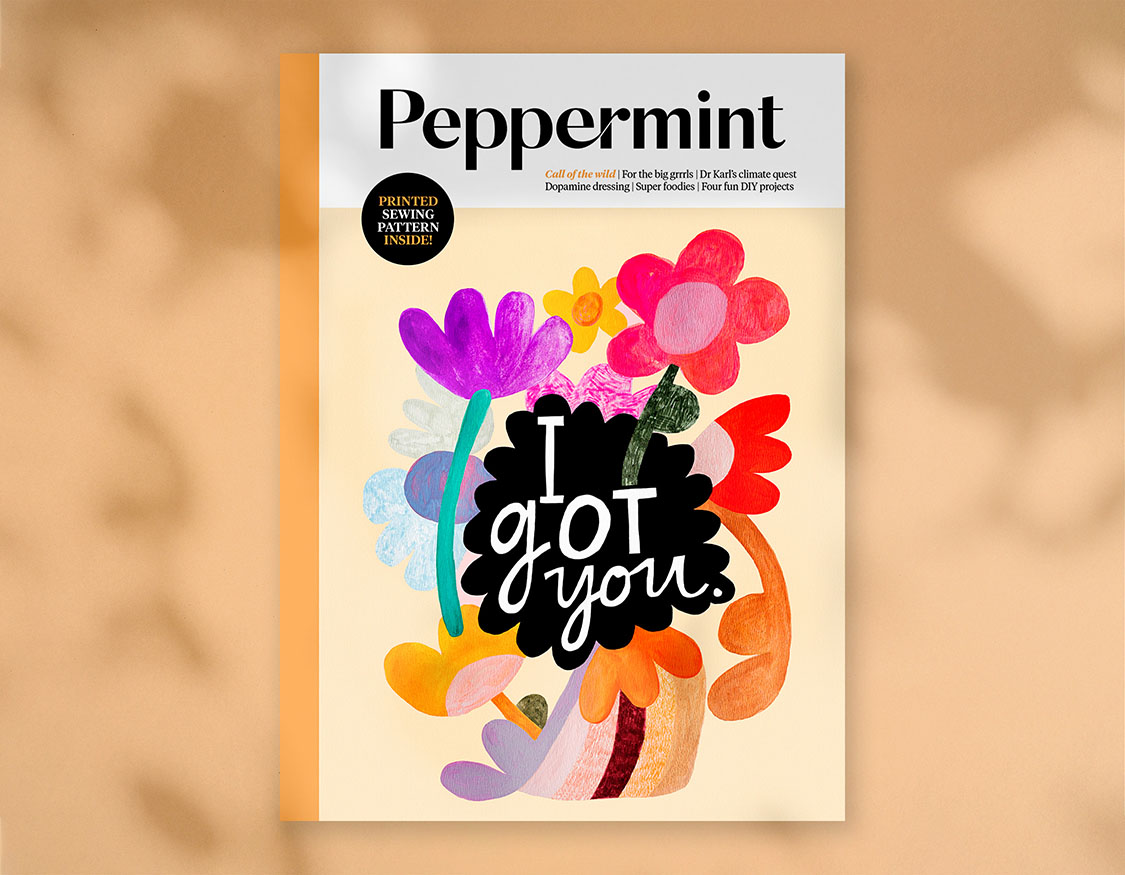
Our Blues-Busting, Bright and Happy Winter Issue is Here!
What are you waiting for? Make some noise for our latest issue, landing on shelves across the country now…
Another season, another jam-packed printed beauty. Beat the winter blues with this bright and happy issue, full of inspiration and hope. From the beautiful artwork created for us by Sydney artist Rachel Castle – more on that below! – to the inspirational back cover quote from biologist and author David George Haskell (pulled from his fabulous book about protecting the aural environment, Sounds Wild and Broken), it’s our hopeful love letter to inspire action for change.
Inside the pages Caitlin Moriarty delves deep into the reality (and her own experiences) of getting physical in a plus-size body; Holly Bodeker-Smith looks into why denim needs to clean up its act; we peer into the forgotten world of Chernobyl’s samoselys (self-settlers) through photographer Cybele Malinowski’s lens; Bundjalung and Worimi saltwater woman Phoebe McIlwraith guides us through walking on Australia’s sacred ground with sensitivity; and we learn about the makers and slow-living philosophy behind Georgian fermented botanical tea brand Nela-Nela.
You’ll also catch up with Dr Karl, Australia’s favourite scientist, as he continues on his STEM-filled climate quest with a wardrobe of loud shirts in tow. We chat with super foodies Melissa Leong, Darren Robertson and Jo Barrett, each doing their bit for sustainable dining; Erin Kendal takes us into her studio and talks following your dreams and creative passions; we try dopamine dressing to help boost our mood with fashion; meet slow fashion merino basics brand Woolerina; Miimi & Jiinda share their powerful stories of resilience and art of healing; and our friends at Spoonflower dish on how they’ve found their prints charming.
On top of another free printed pattern in these here pages, there are four DIYs to get stuck into – knit it out with Cardigang’s easy-to-follow cardi project or do-it-yourself with DIY Daisy as she shares not one, not two, but three whole projects from her new book, Sew it Yourself with DIY Daisy. You can also take a peek inside Kirsten Devitt and Michi de Domahidy’s sunny Murwillumbah “happy shop” and read about how farming intersects with activism for the young family behind organic tea tree farm Olive Gap. Plus our resident sewing wizard, Bonnie Liston, shares the five hand stitches you’ve just gotta know; and Katherine Sabbath cooks up her scrumptious lemon and blueberry drizzle cake for warming the soul on a winter’s day.
And, in case you’ve forgotten already – run, don’t walk for the FREE PRINTED PATTERN!
Pump up your winter reading pile by hitting your closest stockist today or purchase a copy from our shop (and for the digital version, head here).
Take a peek inside this issue!
‘COVER ART’ Rachel Castle – ‘I Got You’.
We were so excited to work with the incredibly talented Sydney-based creative Rachel Castle to bring our cover vision to life – a dedication to everyone out there who’s ever said, “I got you.” While the Oscars might seem like a lifetime ago, one lovely moment between Lady Gaga and Liza Minnelli continues to live rent free in our minds and inspired this botanical beauty. We all need to have each other’s backs at the moment, and this one goes out to our beloved community who have had ours recently. You’re a beautiful bunch! ?
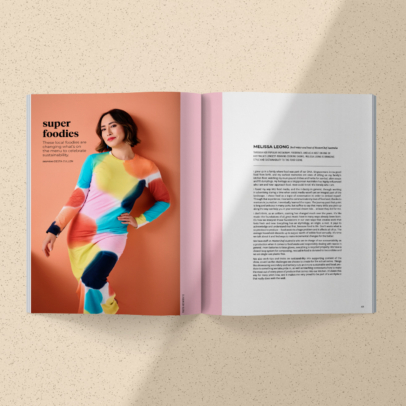
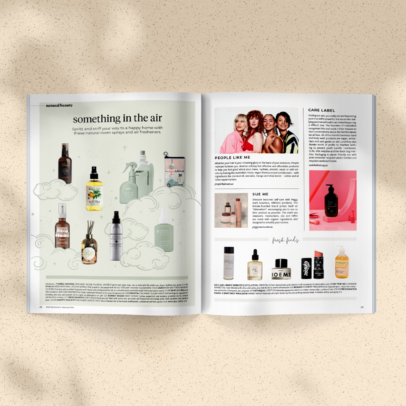
‘MAKING BIG MOVES’ Who said the freedom to move – and be seen doing so – was only for certain body types? Words by Caitlin Moriarty.
The year is 1994. I’m wearing pink lycra and I am finally, finally, doing the splits. The pain (and, oh yes, there is pain) is eclipsed by a heady dose of elation because this could mean something very exciting: I may be able to leave the humble rank of backup dancer and ascend to the front row during my dance team’s next performance.
When I ask my teacher about that coveted centre-stage spot, she hesitates: “It’s just… All the other girls at the front are small. It might look a bit funny if I mix in a bigger girl.” She’s sympathetic – she says she was always the biggest at dancing too and knows it can be hard to always be at the back. But the reality is this: I’m 12 years old and it’s the first time I’m told I’m too fat to do something.
I’m sure I’m not alone in a memory like this. Many adolescents with dreams of greatness have had them dashed by a dance teacher, gymnastics coach or swimming instructor. But, as commonplace as this type of interaction may be, it affected me greatly. It created an inner monologue that still occurs nearly 30 years later: “Your body is wrong, everyone can see that; you can’t do this, it’s not for you.” The shorthand? Too fat for that.
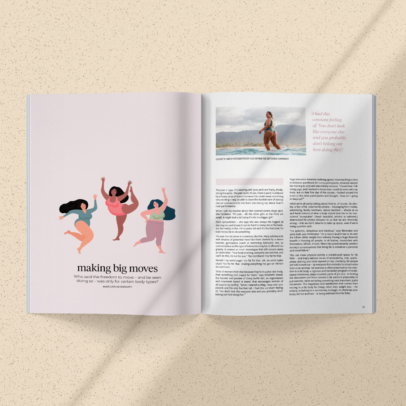
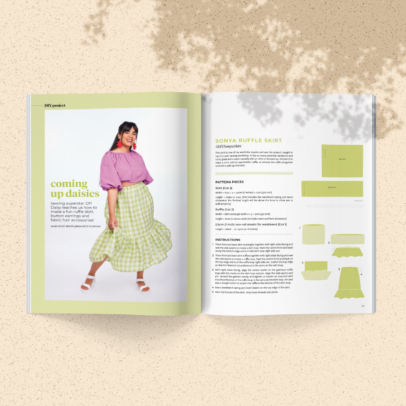
‘MAKE DO AND MEND: THE FIVE HAND STITCHES YOU NEED TO KNOW’ Go back to basics and discover the power of a simple hand stitch for making and mending alike. Words and illustrations by Bonnie Liston.
Hand sewing – or as people called it before the invention of the sewing machine, sewing – is a useful skill for anyone and everyone to learn.
This is not to pit two queens against one another. Of course, none of us long to return to the days before our beloved speedy machines came onto the scene, but hand sewing still has tremendous value as a technique. Whether you’re dealing with fiddly, awkwardly placed seams or delicate, slippery, rippable fabric, the superior control that hand sewing allows can’t be beat. Plus, it promises the perks of portability. You can do it anywhere and everywhere; on the move, lying down, in front of the TV. It can also make for a more slow-paced, relaxing and meditative process than the clickety clack of machine sewing. Even if you’re not one for making your own clothes, hand sewing is a handy hack to keep in your back pocket for mending or minor alterations and attaching any punk-rock patches, alternative adornments or missing buttons.
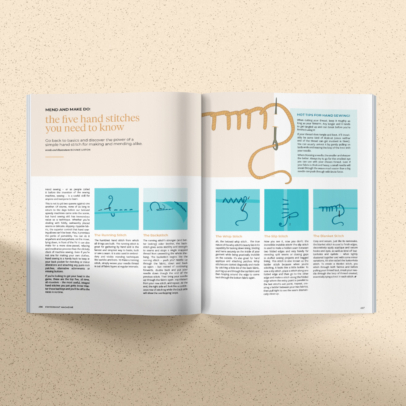
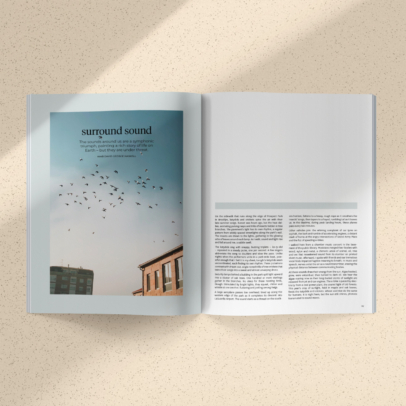
‘STEEPED IN TRADITION’ “Slowly, slowly” is in the name and mission of a company taking ancient Georgian fermented tea traditions and artisan skills to the world. Words by Emily Lush.
It’s a balmy afternoon in Tsageri, a tiny town at the foot of the Greater Caucasus mountain range in north-western Georgia, a small country between Russia, Turkey and the Black Sea. Shota Kopaliani ambles down to the bottom of his garden, pulls open the wooden doors of his micro-factory and empties a bag of hand-foraged mulberry leaves onto his workbench.
The withered table, like the rolling machine and oxidation oven, he built himself. These are the only tools he needs to harness air, movement and heat – the three essential elements for crafting fermented tea. The technique took him two years to perfect, but it’s rooted in a history older than the mulberry-covered hills visible from his window.
Amy Jones stumbled into Shota’s tea-making world by accident. One sip was all it took for Amy, a journalist from the UK, to fall in love with fermented botanical teas – a unique tradition belonging to mountain villages. At the start of 2018, she left her office job in Herefordshire in search of adventure and wound up spending three years in Georgia. “I first arrived on my bicycle,” she remembers. “My goal was to pedal from my hometown in the UK to Singapore, but Georgia has a way of making people stay longer than originally anticipated.”
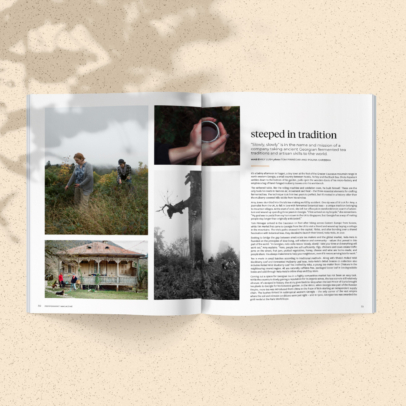
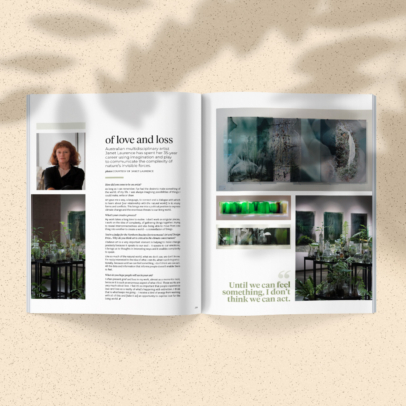
‘THE GOOD DOCTOR’ Champion of the curious mind, Dr Karl has changed the science communication landscape forevermore. Words by Lauren Baxter.
Physicist, medical doctor, engineer, TV weatherman, roadie, car mechanic, taxi driver, labourer: Karl Sven Woytek Sas Konkovitch Matthew Kruszelnicki has worn a lot of hats in his time. But now, the beloved Australian author and science communicator, known affectionately as Dr Karl, calls himself “just a storyteller”.
Popularising science through the power of storytelling, Karl still spends his time making radio and television appearances – he first appeared on the ABC’s 2JJJ in 1981 – giving free school talks – “At the rate I’m going I should get through all the schools in Australia in about a century” – and wearing fabulous shirts.
Bored with beige business button-ups, Karl’s wife, clinician and keen sewist Dr Mary Dobbie, turned a fabric addiction into what’s now something of a trademark. “I love buying fabric,” she exclaims. “I guess that’s really where it comes from. I love fabric. I love touching fabric. I love seeing fabric. I love flicking through bolts of fabric. So this was a way I could buy fabric and Karl never complains. No matter what you choose, he will wear it.” From their medical school days together where Karl would wear “really, really short shorts and message t-shirts” to now, with a wardrobe that celebrates colour, fun and whimsy, it seems like he can thematically match just about any topic.
“He just looks in the cupboard and says, ‘Do I have a shirt that would speak of trees in non-plantation forests?’” Mary laughs.
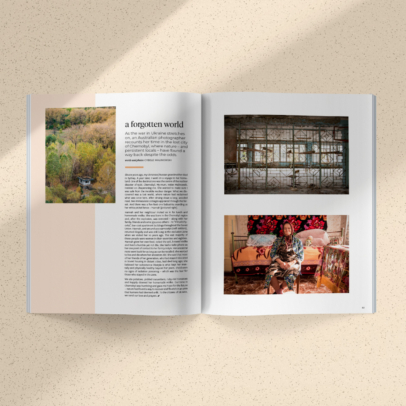
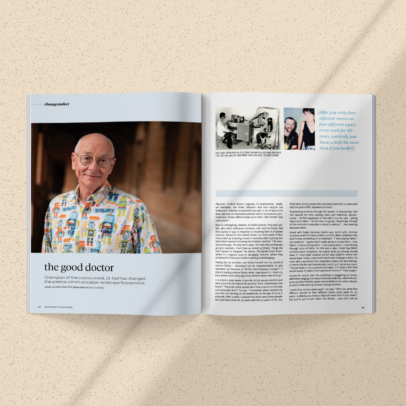
‘A FORGOTTEN WORLD’ As the war in Ukraine stretches on, an Australian photographer recounts her time in the lost city of Chernobyl, where nature – and persistent locals – have found a way back despite the odds. Photo essay and words by Cybele Malinowski.
Eleven years ago, my Ukrainian/Russian grandmother died in Sydney. A year later, I went on a voyage to her homeland. One of the destinations was the centre of the nuclear disaster of 1986, Chernobyl. My mum, Helen Malinowski, insisted on chaperoning me. She wanted to make sure I was safe from the invisible nuclear danger. What we discovered was a lost world, where nature had reclaimed what was once hers. After driving down a long, wooded road, two immaculate cottages appeared through the forest. And there was a five-foot-one babushka standing at her white picket fence – Hannah.
‘ALL TALK, NO TROUSERS’ Estimates suggest half the people on the planet, at any one time, are wearing jeans. But denim is doing us dirty and these local innovators are shaking things up. Words by Holly Bodeker-Smith
While fashion constantly evolves, one trend endures: denim jeans. Whether high-waisted, low-rise, stone-washed or barely washed, most can think of a pair they love (or loved to death). Durable by design, a high-quality pair can last a lifetime. And yet, estimates for annual jean production sit anywhere between 2 and 6 billion pairs. Closer to home, according to 2016 Roy Morgan figures, almost 2 million Australians buy a new pair each month.
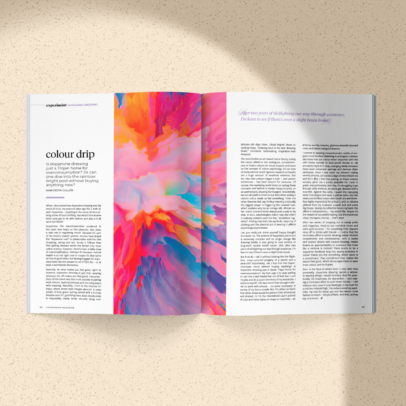
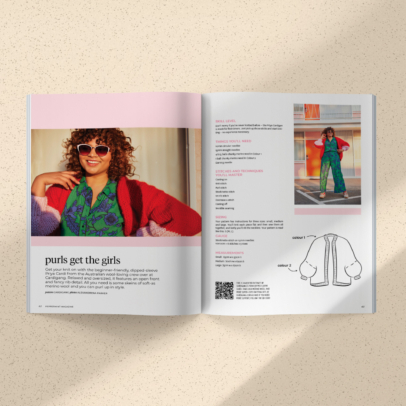
‘COLOUR DRIP’ Is dopamine dressing just a Trojan horse for overconsumption? Or can one dive into the rainbow bright pool without buying anything new? Words by Desta Cullen.
Dopamine, the neurotransmitter produced in the brain that helps us feel pleasure, also plays a vital role in regulating mood. Because it’s part of the brain’s reward system, studies have linked the “dopamine rush” to pleasurable activities like shopping, eating and sex. Surely it follows then that getting dressed works the same? Like most online science, however, there’s been a hefty dose of oversimplification. Perhaps it’s because mental health is so hot right now or maybe it’s that we’re all low on good vibes, but finding triggers for dopamine feels like the answer to all of life’s ills – or at least a worthwhile distraction.
Basically, do what makes you feel good, right? In essence, dopamine dressing is just that: wearing whatever the eff makes you feel good. Interpretations of the trend vary but most popular is pairing bold colours, layering textures and choosing items with meaning. Naturally, I turn to the internet for inspo, where street-style images abound. A zesty splash of lime green suiting paired with a fuchsia bralette and OTT gold bling here. Bold chunky knits in impossibly clashy tones casually slung over delicate silk slips there. Cloud-shaped shoes in rainbow hues.
“Dressing loud is the new dressing down,” proclaims tastemaking inspiration-hub Pinterest.
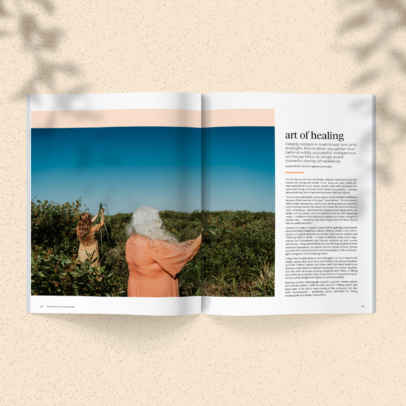
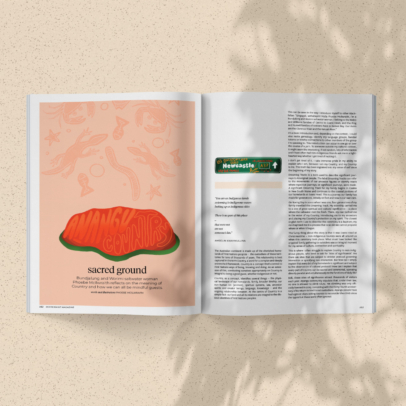
‘ART OF HEALING’ Deeply rooted in matrilineal lore and strength, the mother-daughter duo behind wildly successful Indigenous art house Miimi & Jiinda share powerful stories of resilience. Words by Helen Dewar
For as long as she can remember, Melissa Greenwood has witnessed the therapeutic power of art. Since she was a little girl, she’s watched her mum, Lauren Jarrett, paint with a purpose that came from being a member of the Stolen Generations – creating pieces that help her to heal and reconnect with her culture.
“Mum’s been painting for over 30 years, but she lacked confidence because of the traumas of her past,” says Melissa. “She’s a survivor of the Stolen Generations, and for her, painting plays an important role in healing trauma that stems from what she experienced as a child. Growing up, I witnessed the injustices that happened to my family and my people, and the injustices that are still happening today. It instilled in me a drive and a passion to create change in a positive way – I wanted to see Mum happy and confident, and so Miimi & Jiinda was born.”
‘SACRED GROUND’ Bundjalung and Worimi saltwater woman Phoebe McIlwraith reflects on the meaning of Country and how we can all be mindful guests.
I often struggle to explain Country to non-Indigenous people, who tend to ask for ‘sites of significance’. Yes there are sites that are subject to stricter protocol governing interaction or specifying non-interaction. But how can I simply explain that every bit of my homelands is significant and subject to the observation of cultural protocol? How can I explain that every part of Country can be sacred and ceremonial, operating directly parallel and simultaneously to the functions of daily life?
